To increase financial inclusion and reduce transaction costs, Peru is considering the idea of establishing a CBDC, according to a report by the Central Reserve Bank of Peru.
- The first in a series of reports on the need, structure, and timing of a Peruvian CBDC has been published by the Central Reserve Bank of Peru (CRBP).
- Given that roughly half of the population of Peru does not have access to a bank account, the goal of a CBDC within the framework of the country’s payment system is to provide people with access to digital payments.
CRBP Report
To enhance the nation’s payment system, Peru is considering introducing a central bank digital currency (CBDC). A report on the requirement, structure, and timing of a Peruvian CBDC, the first in a series, was published by the Central Reserve Bank of Peru (CRBP). According to the CBRP, Peru’s current situation of competing payment systems could be more sustainable. However, establishing a CBDC and new regulations to increase access and interoperability of existing systems would assist the central bank in removing obstacles to financial inclusion and bringing down transaction costs.
The Objectives of a CBDC in Peru
Providing access to digital payments for the unbanked population is the goal of a CBDC within the context of Peru’s payment system. To create an implementation plan, it is crucial to understand their traits. Peru faces significant challenges because around half of the country’s citizens have bank accounts. About 79% of the unbanked, who make up three-quarters of the population, do not have any savings. They almost all have informal jobs and primarily reside in urban areas. The majority of unbanked people have smartphones.
Since 2015, the research claims, Peru has seen a fivefold increase in the use of digital payments. To ensure that its citizens are financially included, Peru still has a long way to go. A CBDC could increase the usability and effectiveness of digital payments, especially for the unbanked population.
The Current Progress of CBDC Development
The first of five processes in the prospective production of a CBDC was completed with the release of the current report. There was no mention of a development timetable for CBDC. A 25-question user survey, with a deadline of April 30, was also made available by the CBRP. The survey aims to learn more about the traits of the CBDC’s potential users.
Following a May 2021 agreement, the International Monetary Fund (IMF) provided technical support to Peru for the report’s development. Julio Velarde, the president of the CBRP, declared in November 2021 that the nation will work with Hong Kong, Singapore, and India to create a CBDC.
The Future of a CBDC in Peru
The creation of a CBDC might fundamentally alter Peru’s payment system. Particularly for the unbanked population, it might increase the efficiency, security, and accessibility of digital payments. But before a CBDC is implemented, Peru must first overcome several obstacles. It’s essential to teach unbanked people how to use digital payments. The current payment systems’ interoperability needs to be strengthened. The CBDC must be integrated with the existing payment infrastructure.
Conclusion
Peru is looking into the potential of establishing a CBDC to upgrade the nation’s payment infrastructure. A CBDC could be implemented to increase the efficiency, security, and accessibility of digital payments, particularly for the unbanked population. The CBDC would assist the central bank in lowering transaction costs and removing obstacles to financial inclusion. It’s essential to teach unbanked people how to use digital payments. The current payment systems’ interoperability needs to be strengthened. The CBDC must be integrated with the existing payment infrastructure. The effectiveness with which these issues are resolved will determine the outcome of a CBDC in Peru.














